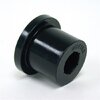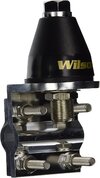Something is missing! All the required parts should have been with the mounting bracket. If a steel washer is on the bottom and touching the metal bracket, that's a no-no. A Teflon isolator shall be on the top and bottom of the metal bracket.Mine just had a large thick black insulator that's underneath the black cone thats between it and top of bracket it sits on.
You are using an out of date browser. It may not display this or other websites correctly.
You should upgrade or use an alternative browser.
You should upgrade or use an alternative browser.
-
You can now help support WorldwideDX when you shop on Amazon at no additional cost to you! Simply follow this Shop on Amazon link first and a portion of any purchase is sent to WorldwideDX to help with site costs.
-
A Winner has been selected for the 2025 Radioddity Cyber Monday giveaway! Click Here to see who won!
Swr problem on 102" whip
- Thread starter Dannell Boyd
- Start date
I respectfully disagree. No bottom insulator is used. The SO239 and its steel washer connect directly to the bracket. That allows a ground to be established for the radials because the braid in the coax is connected to the outer shell of the SO239.
Otherwise the radials and the counterpoise they provide are not connected to anything and are just blowin’ in the wind.
Otherwise the radials and the counterpoise they provide are not connected to anything and are just blowin’ in the wind.
Last edited:
No my bracket is thinner than theirs. I had to build my own because I had to mount it to a1 1/4" pipe and their bracket wasn't wide enough.Is your home-brew bracket thicker than the Wilson backet? Could it be you did not install the bottom insulator washer because there weren't enough threads because of the thicker bracket?
Well, good luck to you because I'm fresh out of ideas.
Welcome aboard!
Thanks for you guys helpWelcome to the forum Dannell. You'll want your antenna to look something similar to one of these. 3 or 4 radials will work better than 1 or 2 if you can.
View attachment 56749
Follow Riverman's construction advice and you'll be cooking with gas.
73 and good luck
I want to thank all you guys for your help, I'm going to take that mount apart tomorrow and see what's what. I know about your basic so-239 stud mount but this one was some different and it may be something I did wrong. I'm not transmitting on my radio with the high swr's till I get it right. This was supposed to be temporary till I get my lean over pole built and use an old A99 I had . So later guys, I'll post on my progress in a few days.Mine just had a large thick black insulator that's underneath the black cone thats between it and top of bracket it sits on.
OK, I agree, but I'm almost positive that there is supposed to be a Teflon isolator sleeve / bushing in the hole in the bracket where the SO-239 passes through to prevent the SO-239 contacting with metal. As I suggested, the first experiment would be to remove the spring and check the SWR and go from there.I respectfully disagree. No bottom insulator is used. The SO239 and its steel washer connect directly to the bracket. That allows a ground to be established for the radials.
Otherwise the radials and the counterpoise they provide are not connected to anything and are just blowin’ in the wind.
Yes and no. A tiny part of the top insulator fits inside the hole allowing the inner part of the SO239 to safely pass through without contacting metal, connecting the coax center conductor to the isolated antenna. The outer part of the SO239 and steel washer screw tightly against the metal bracket, connecting the coax braid to the bracket for grounding/counterpoise purposes.OK, I agree, but I'm almost positive that there is supposed to be a Teflon isolator sleeve / bushing in the hole in the bracket where the SO-239 passes through to prevent the SO-239 contacting with metal. As I suggested, the first experiment would be to remove the spring and check the SWR and go from there.
Yes, a "step" (non-metallic) isolator bushing should be inserted in the bracket. Being that his home-brew bracket is thinner than an original, he may have installed the isolator bushing inverted and not in the hole of the bracket.Yes and no. A tiny part of the top insulator fits inside the hole allowing the inner part of the SO239 to safely pass through without contacting metal, connecting the coax center conductor to the isolated antenna. The outer part of the SO239 and steel washer screw tightly against the metal bracket, connecting the coax braid to the bracket for grounding/counterpoise purposes.

Does it look like this?Something is missing! All the required parts should have been with the mounting bracket. If a steel washer is on the bottom and touching the metal bracket, that's a no-no. A Teflon isolator shall be on the top and bottom of the metal bracket.
Attachments
Could you have possibly installed the bushing inverted because the length of the bushing is longer than the thickness of the mounting plate. If you did, the SO-239 is in contact with the hole.Something is missing! All the required parts should have been with the mounting bracket. If a steel washer is on the bottom and touching the metal bracket, that's a no-no. A Teflon isolator shall be on the top and bottom of the metal bracket.
Attachments
Looking at Recon's picture in post #28, I don't see any slots in the threaded portion of the S0-239. I have seen this before. It does not allow the PL-259 to seat properly to the S0-239. Typically there are 4 "Barbs" on the "braid side" of the PL-259 connector. Easily solved with a Dremel tool on the S0-239 so that the PL-259 seats completely in the S0-239.
Just a random thought.
73
David
Just a random thought.
73
David
I agree! I've had a few SO-239 connectors without the barbs / cut-outs, and I used a jewelers triangle file to make the barbs / cut-outs. Just another manufacturer's cost savings tactic by eliminating the machining process.Looking at Recon's picture in post #28, I don't see any slots in the threaded portion of the S0-239. I have seen this before. It does not allow the PL-259 to seat properly to the S0-239. Typically there are 4 "Barbs" on the "braid side" of the PL-259 connector. Easily solved with a Dremel tool on the S0-239 so that the PL-259 seats completely in the S0-239.
Just a random thought.
73
David
I'd just like to see you make some sucess over the effort.
You're making a simple dipole - only the 102" side needs something to work against - so the shield of the coax is not enough by itself - you'll need extra metal to do it.
You have the right concepts - just have to make the SHIELD of the COAX become your lower radials as shown in the middle graphic.
The shield from the coax cannot short out to the center - in this setup - for it could damage the radio from unable to get a good SWR period.
They usually go 4 "arms" and 1 vertical like the others show you in the diagrams.
You just need enough "image" from those radial arms to keep the SWR low enough.
The original idea just didn't give you enough counterpoise metal image to work with.
Yes, a "step" (non-metallic) isolator bushing should be inserted in the bracket. Being that his home-brew bracket is thinner than an original, he may have installed the isolator bushing inverted and not in the hole of the bracket.
Ah!
I can see one like that being a problem. I was picturing one like this.
 Not This:
Not This: 
Last edited:
Exactly! The thickness of the Wilson bracket is either 1/4" or 5/16" and his home-brew bracket is thinner, but who knows how much thinner. I would estimate the inserted length of the original isolator step-bushing / sleeve is 1/32" thinner than the Wilson bracket. My hunch is the step-bushing is not inside the hole.Ah!
I can see one like that being a problem. I was picturing one like this.
View attachment 56771 Not This: View attachment 56772
Exactly! The thickness of the Wilson bracket is either 1/4" or 5/16" and his home-brew bracket is thinner, but who knows how much thinner. I would estimate the inserted length of the original isolator step-bushing / sleeve is 1/32" thinner than the Wilson bracket. My hunch is the step-bushing is not inside the hole.
I finally understand what you're saying.
(Took me four attempts but finally got a decent pic of my teflon washer.)



